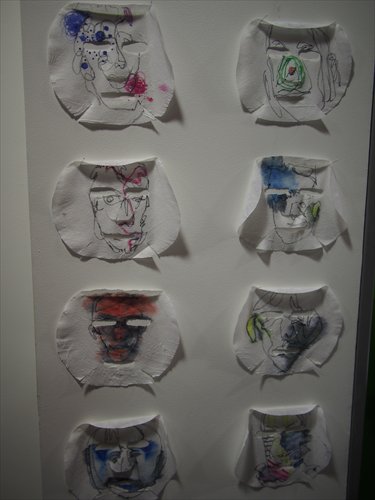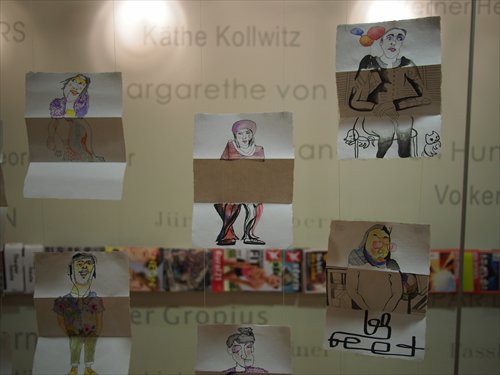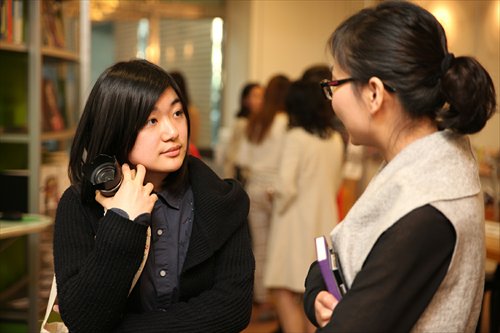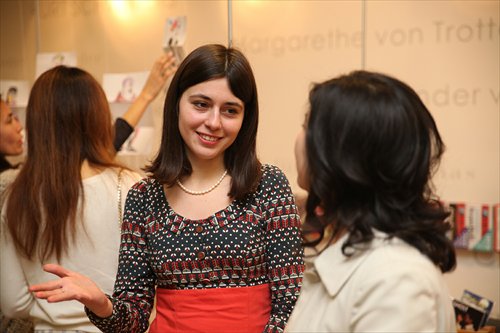Face time
Transcontinental project explores portraiture through digital linkups
It all started in 2012 with Henning Eichinger, an art professor from Reutlingen University in Germany, wondering what it would be like if students from across the world made portraits of each other via Skype.
With Maggie McCormick from RMIT University in Australia, he turned the idea into Skypelab, a transcontinental joint project bringing together art, design and technology.
The project moved on to include Asia in 2014, and Shanghai's East China Normal University (ECNU) joined, with assistant professor Ma Yonglei as the third curator. Last Sunday, 12 students, four from each of the three universities, presented their artworks at Skypelab, an ongoing exhibition at the Abteilung Kultur Und Bildung on Fuzhou Road.

pieces drawn by students from different countries Photos: Courtesy of the event organizer and Liao Fangzhou/GT

pieces drawn by students from different countries Photos: Courtesy of the event organizer and Liao Fangzhou/GT

Participating students

Participating students

Participating students

three curators of the exhibition
Each student drew participants from the other two universities, one by one, while having a video chat via Skype. The point of departure for their artworks, which appear in various forms including collages, postcards, knitworks, and videos, is always the initial sketches.
Drawing blindly
"For this crazy idea, we needed a crazy drawing method called blind contour drawing," Reutlingen told the Global Times. "It is a funny way of drawing with a couple of rules - you don't look at your hands or pens, but at the objects you see. You draw lines and outlines without taking the pen from the paper."
The process of blind contour drawing shifts brain activity from the left to the right side, which is more creative and playful, according to Betty Edwards, former art teacher at California State University.
McCormick said the project explores the role of drawing and portraiture in culture identity and perception, and how it is mediated through the digital screen, particularly the public space of Skype.
"The aim is to understand more fully the nature of culture identity that is being defined by the urbanized and digitalized world," said McCormick.
She believes the project reinforces the idea that, when we look at the screen, we are mirroring ourselves as much as seeing each other. "The idea of portraiture becomes less an interpretation of the individual, but an interpretation of the collective consciousness," McCormick said.
Javiera Advis from Germany drew the heads of other participants and sent the portraits to Australia, where Australian students drew the torsos, and then to China, where Chinese students drew the legs, all according to their imagination of the person they knew only by the face.
These drawings were done in a cartoon-like manner and the colors stand out as the most vivid among the exhibits. The three parts of each piece are joined together to make up a complete full-body sketch. Hung by strings, they are linked to letters that these students wrote to each other during the project.
Imagine the missing
"What we miss when we use Skype is the feeling - touching and smelling," Advis told the Global Times. "By sending letters, you are sending a part of you physically - your handwriting, the trace in your paper, the letter itself, something physical you can touch. It covers the distance you cannot travel, and brings with it a part of you."
Huang Yuemin, an art student from ECNU, retouched the blind contour drawings and applied them to facial masks (pictured top right), which are hung on a wall near the entrance of the Abteilung Kultur Und Bildung. "The idea is that you always have two faces anyway, a real one and another transmitted and seen on the screen," Huang said.
While most works focus on images, some students are more interested in sounds. Chinese student Sun Fanding made a video that combines the sketches and a recording of the sounds she heard when chatting on Skype. "They were sounds in my headset that my counterparts could not hear - they are like sounds made by dinosaurs or from outer space, and seem to come from not the actual environment but the equipment itself, perhaps the computer. This makes me want to share them with everyone," Sun said.
Asking questions
The project is also trying to collect 100 questions that rise from the practices and works. Starting with Europe and Australia in 2012, and Asia in 2014 and 2015, it will move on to South America to gather questions, said McCormick.
On the project's official website, the latest question is posted by Giordano Biondi, one of the Australian students taking part in the exhibition: "The pixelation and distortion that come with Skype. Are they an inspiration for art making or are they issues to deal with that provide only problems?"
"When we ask questions, we gain knowledge," McCormick told the Global Times. "The outcome will be presented in an exhibition in Germany in 2016."
Claus Heimes, culture consul at the Abteilung Kultur Und Bildung, said the exhibits - plastered on the glasses, displayed on the bookshelves, coming out of machines, shown on the computer screens - fit the office environment perfectly, as if they belong here.
"Skype is a game of closeness and distance, an issue that the project deals with in the means of art, and at the same time the point of cultural dialogue which our office aims at," Heimes said.
Date: Until April 24
Venue: Abteilung Kultur Und Bildung
德国驻上海总领事馆文化教育处
Address: Room 101, 318 Fuzhou Road
福州路318号101室
Call 6391-2068 for more detailed information